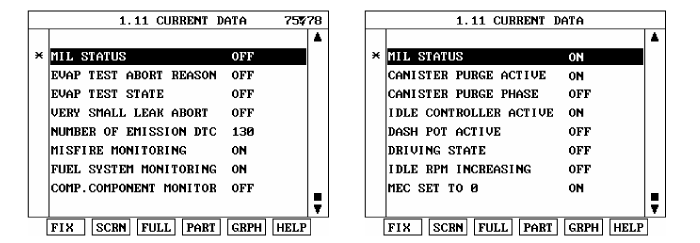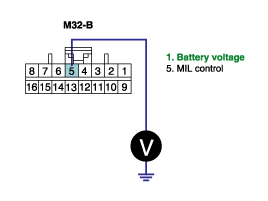Compare "Current data" on scantool with "Engine Warning Lamp" on cluster.

As monitoring the errors of several sensors and actuators circuit,if any problem occurs, PCM turns engine check lamp ON at cluster to notify driver occurence of a problem.Generally, engine check lamp turns ON at Ignition ON and turns OFF within couple of seconds after turning engine ON. If engine check lamp turns on during driving, perform diagnosis of engine system and auto-transaxle system.
Checking input signal of engine check lamp every 10 sec. under detecting condition, if open, or short to battery or ground is detected for more than 5 sec., PCM sets P0650.
Item | Detecting Condition | Possible cause | |||||
DTC Strategy | ● Signal low, high | ● Poor connection ● Open or short in MIL circuit ● Faulty MIL ● Faulty PCM | |||||
Enable Conditions | ● After 0.5 sec under conditions below ● Engine works ● 11V ≤ Battery voltage ≤ 16V | ||||||
Threshold value | ● Open or short | ||||||
Diagnosis Time | ● Continuous (More than 5 seconds failure for every 10 seconds test) | ||||||
MIL On Condition | ● DTC only (NO MIL ON) | ||||||

IG "OFF" & connect scantool.
ENG "ON" and warm -up the engine to normal operating temperature.
Compare "Current data" on scantool with "Engine Warning Lamp" on cluster.

Is the current data displayed correctly ?

▶ Fault is intermittent caused by poor contact in Sensor’s and/or PCM’s connector or was repairedand PCM memory was not cleared. Thoroughly check connectors for looseness, poor connection,bending, corrosion, contamination, deterioration, or damage. Repair or replace as necessary and goto "Verification of Vehicle Repair" procedure

▶ Go to "Terminal and Connector Inspection" procedure.
Many malfunctions in the electrical system are caused by poor harness and terminals. Faults can also be caused by interference from other electrical systems, and mechanical or chemical damage.
Thoroughly check connectors for looseness, poor connection, bending, corrosion, contamination, deterioration, or damage.
Has a problem been found?

▶ Repair as necessary and go to "Verification of Vehicle Repair" procedure

▶ Go to " Power Circuit Inspection " procedure.
IG "OFF" and disconnect Instrument cluster connector.
IG "ON" and ENG "OFF"
Measure voltage between terminal 5 of instrument cluster harness connector and chassis ground.
Specification : Approx. B+

Is the measured voltage within specification?

▶ Go to "Control Circuit Inspection" procedure.

▶ Check fuse between battery and instrument cluster for open or blown-off.
▶ Repair open or short to ground in harness, and go to "Verification of Vehicle Repair" procedure.
IG "OFF" and disconnect PCM connector.
IG "ON" and ENG "OFF"
Measure voltage between 63 of PCM harness connector and chassis ground.
Specification : Approx. B+

Is the measured voltage within specification?

▶ Go to "Component Inspection" procedure.

▶ Check open in Engine warning lamp's filament.
▶ Repair open or short to ground in harness, and go to "Verification of Vehicle Repair" procedure.
Check instrument cluster
IG "OFF"
Substitute with a known - good instrument cluster and check for proper operation.
Does it normally operate after replacement?

▶ Replace instrument cluster and go to "Verification of Vehicle Repair" procedure.

▶ Substitute with a known - good PCM and check for proper operation. If the problem is corrected, replace PCM and go to "Verification of Vehicle Repair" procedure.
There is a memory reset function on scantool that can erase optional parts automatically detected and memorized by PCM. After testing PCM on the vehicle, use this function to reuse the PCM on the others
After a repair, it is essential to verify that the fault has been corrected.
Monitor and record the Freeze Frame Data for the Diagnostic Trouble Code(DTC) which has been diagnosed.
Using a Scantool, Clear the DTCs
Operate the vehicle within conditions noted in the freeze frame data or enable conditions
Monitor that all rediness test have been verified as " Complete "
Are any DTCs present ?

▶ Go to the applicable troubleshoooting procedure.

▶ System is performing to specification at this time.